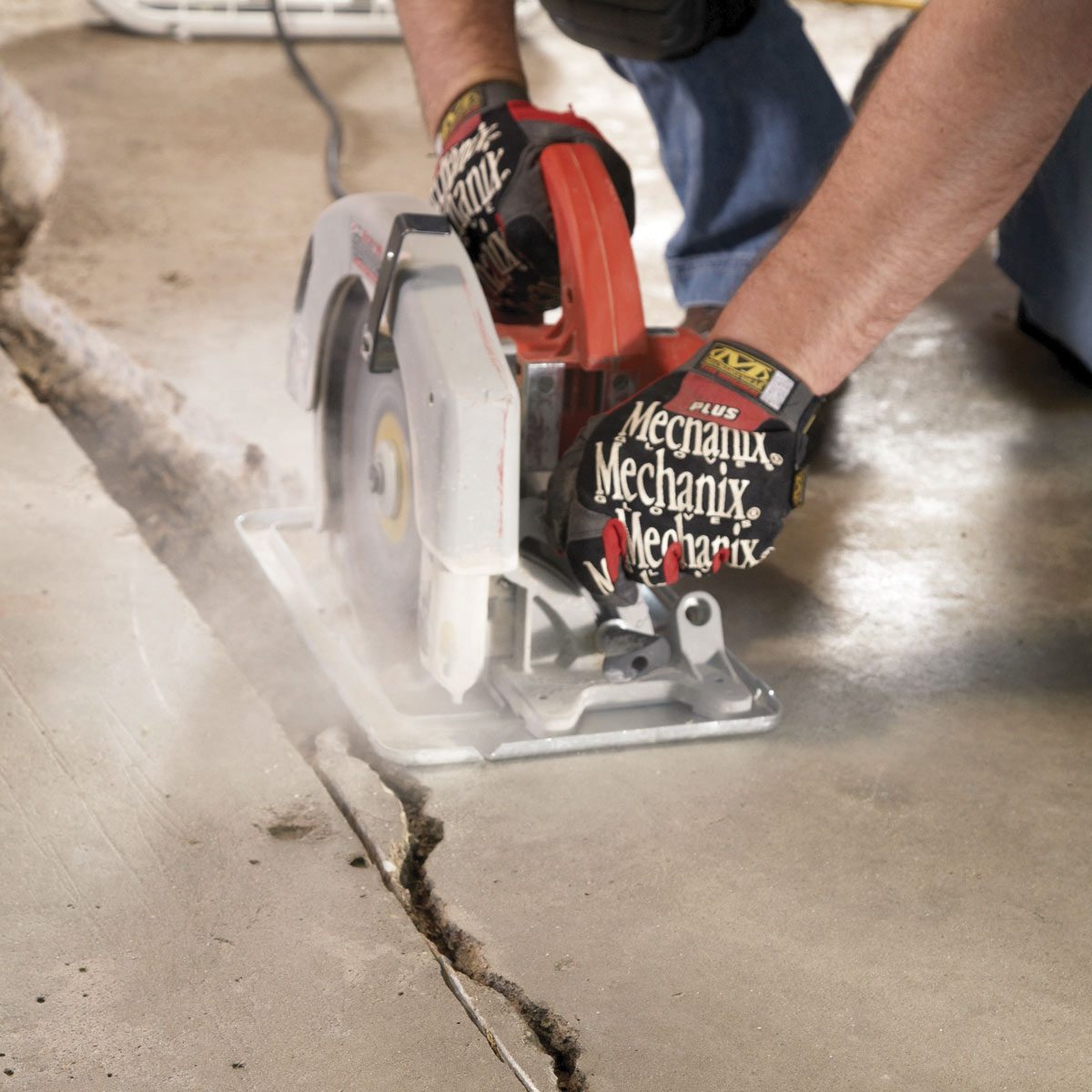You can fix many concrete cracks yourself.
A full day
Intermediate
$51–100
Introduction
Fix the crack in your concrete garage or basement floor yourself by following these step-by-step directions.
It’s common for concrete to crack. Freezing and thawing in cold climates can cause it to heave, and tree roots can grow up from below. Sometimes it’s just that it wasn’t mixed or set right to begin with. Regardless of the reason, once you see a crack, fixing it promptly can save you hassles down the road.
“Cracks in your concrete floor allow for moisture, mold and long-term damage,” says Hayden Slack of G.L. Hunt Foundation Repair. “These cracks can widen or deepen, especially if there’s soil movement beneath the slab.”
The good news is that concrete crack repair can be a DIY project if you’re comfortable with the tools and materials involved. For hairline and small cracks, a good epoxy or polyurethane injection kit can be enough. Otherwise, it’ll require these extra steps.
Also, keep in mind that sealing a crack is just one part of the job,” says Slack. “Taking time to prep right and understand what’s happening below the surface is what makes a repair last.”
Here’s how to fill the crack in your concrete garage or basement floor yourself with these step-by-step directions.
Tools Required
- Bucket
- Circular saw
- Cold chisel
- Dust mask
- Trowel
Materials Required
- Concrete mix
- Concrete resurfacer
- Latex modifier
Project step-by-step (4)
Cut a groove on both sides of the cracked concrete

Using a diamond blade on your circular saw, cut a 1/2-in.-deep groove along each side of the crack. Wear an N-95 respirator and turn on a fan to blow the concrete dust out of the garage. Chip out the cracked portion with a maul and cold chisel.
Fill with a polymer-modified cement such as Quikrete concrete resurfacer No. 1131. Our crack was wide and deep, so we chiseled out the entire opening and refilled it.
- Note: Concrete cracks are caused by sideways expansion, poor drainage conditions or settling soil beneath the concrete. If your concrete is the same height on both sides of the crack, you can fix it yourself. But you have to enlarge the crack. Then power-wash the area and squeegee off the excess water before applying the concrete crack filler.
However, if one side of the crack is lower, call an expert to diagnose and fix the underlying soil/drainage problem. Then either replace the sunken portion or call a mud-jacking company to raise it.
“DIYers usually just seal the crack without getting to the root problem,” says Slack. “If the soil is moving, filling a crack won’t stop others from appearing or this one from opening back up. If there’s a structural issue, you need a professional.”
Remove the cracked concrete

Chip out the cracked portion with a maul and cold chisel. Remove the chipped pieces and vacuum out the crack before power washing. Chip out the cut concrete to get a fresh surface so the new concrete can bond to it.
Fill in the cracked concrete opening

Add a latex modifier to the regular concrete mix and pack it into the channel. Fill to within 1/2 inch of the original height. Let it sit for a few days, then fill with resurfacer. Establish a solid base for the resurfacer by filling the opening with concrete and letting it dry (see Photo 3).
“Make sure the crack is clean and dry before applying any sealant,” says Slack. “If it’s wet, the repair material won’t bond properly.
Check for moisture before sealing, especially if you’re working in a basement or other below-grade area, since moisture will cause the repair to fail. “Use a piece of paper by touching it to the surface,” says Slack. If there’s moisture, it’ll show up. Installing a vapor barrier or drainage system could be necessary, and that adds cost.”
Add the resurfacer

Pour concrete resurfacing mixture into the crack and smooth it out with a rubber floor squeegee. Feather the edges to get the best appearance. Add water to the resurfacer mix to get the consistency of pancake batter for the concrete crack filler. Then fill the remainder of the groove and smooth it over.
FAQs
Why does concrete crack?
Concrete is brittle, and it shrinks as it cures, and extreme temperatures or improper mix ratios during installation can worsen this. “Also, when soil shifts or contracts, it can leave gaps that the slab settles into, causing cracks,” says Slack.
How long does concrete crack repair last before it needs redoing?
How long concrete crack repairs last depends. A proper concrete crack repair can last for years. But if the crack was caused by shifting soil or other outside factors, then unless those are addressed, it’s likely to crack again. The lifespan also depends on the sealant used and the condition of the surrounding concrete.
About the Expert
- Hayden Slack is owner of G.L. Hunt Foundation Repair in Fort Worth, Texas, where he’s also worked as general manager since 2014.




















